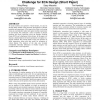Free Online Productivity Tools
i2Speak
i2Symbol
i2OCR
iTex2Img
iWeb2Print
iWeb2Shot
i2Type
iPdf2Split
iPdf2Merge
i2Bopomofo
i2Arabic
i2Style
i2Image
i2PDF
iLatex2Rtf
Sci2ools
ATAL
2008
Springer
2008
Springer
Individual differences in expressive response: a challenge for ECA design
To create realistic and expressive virtual humans, we need to develop better models of the processes and dynamics of human emotions and expressions. A first step in this effort is to develop means to systematically induce and capture realistic expressions in real humans. We conducted a series of studies on human emotions and facial expression using the Emotion Evoking Game (EVG) and a high-speed video camera. In this paper, we discuss a detailed analysis of facial expressions in response to a surprise situation. We provide details on the rich dynamics of facial expressions, along with data useful for animation of virtual human. The analysis of the data also revealed considerable individual differences in whether surprise was evoked and how it was expressed. Categories and Subject Descriptors I.2.11 [Distributed Artificial Intelligence]: Intelligent agents I.3.7 [Three-Dimensional Graphics and Realism]: Animation General Terms Measurement, design, experimentation, human factors, theory...
| Added | 12 Oct 2010 |
| Updated | 12 Oct 2010 |
| Type | Conference |
| Year | 2008 |
| Where | ATAL |
| Authors | Ning Wang, Stacy Marsella, Tim Hawkins |
Comments (0)

